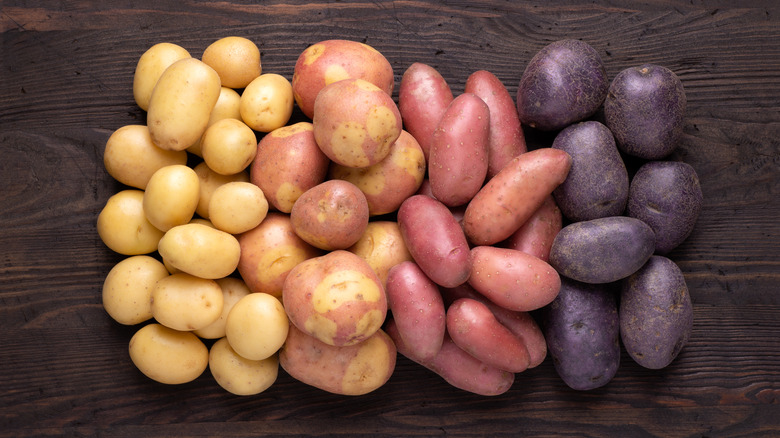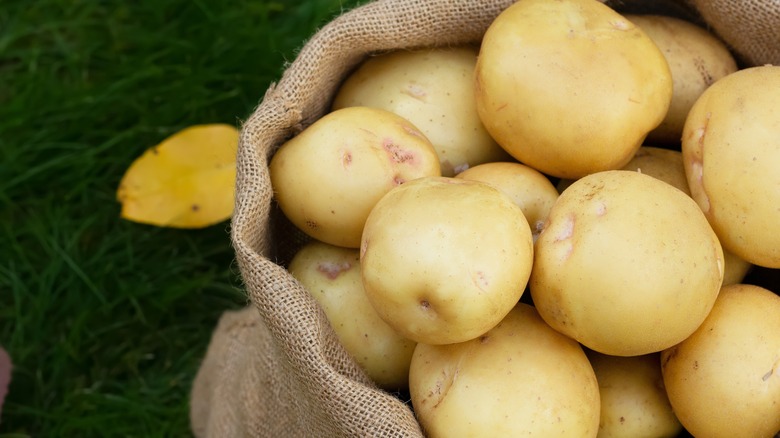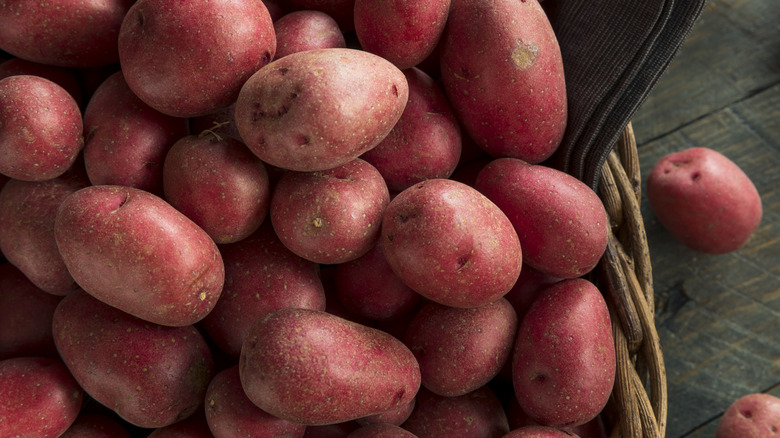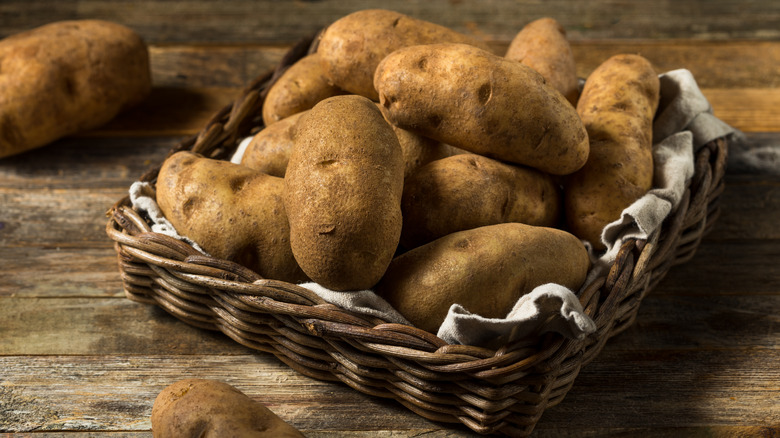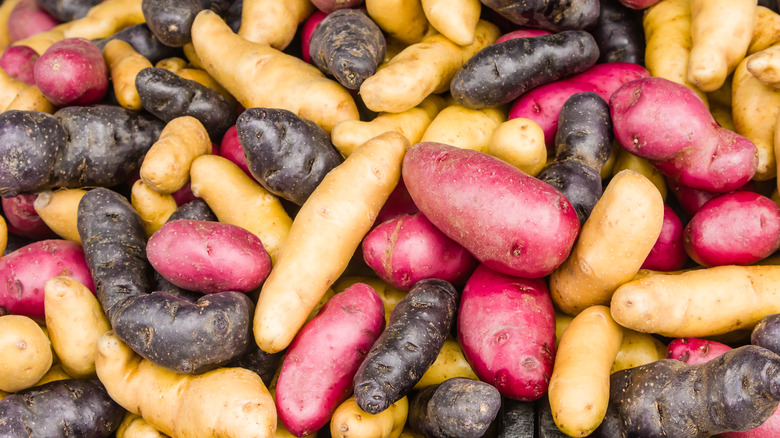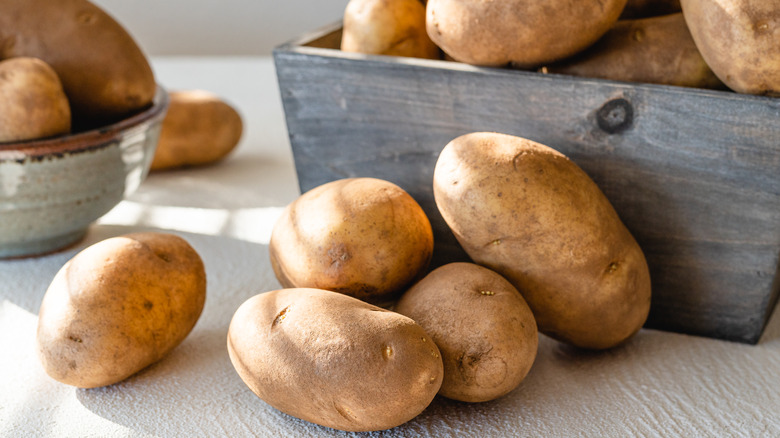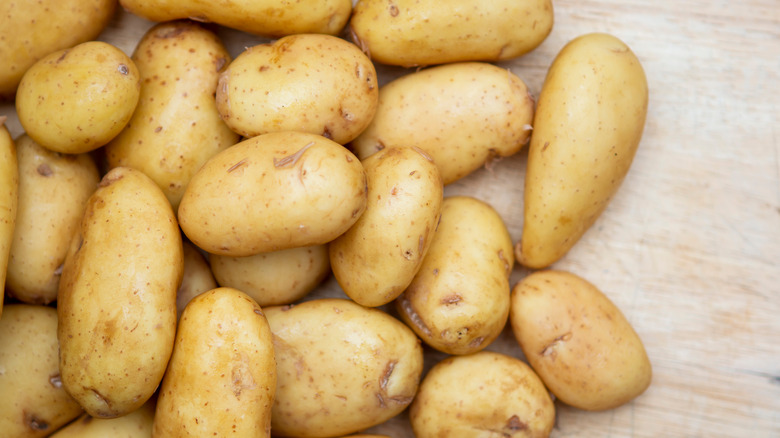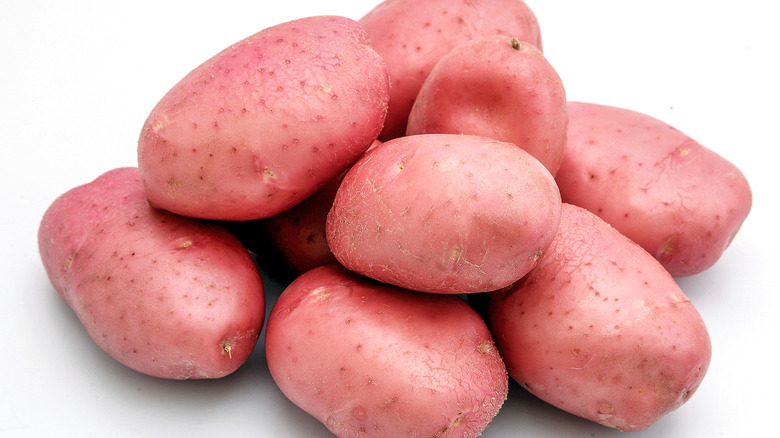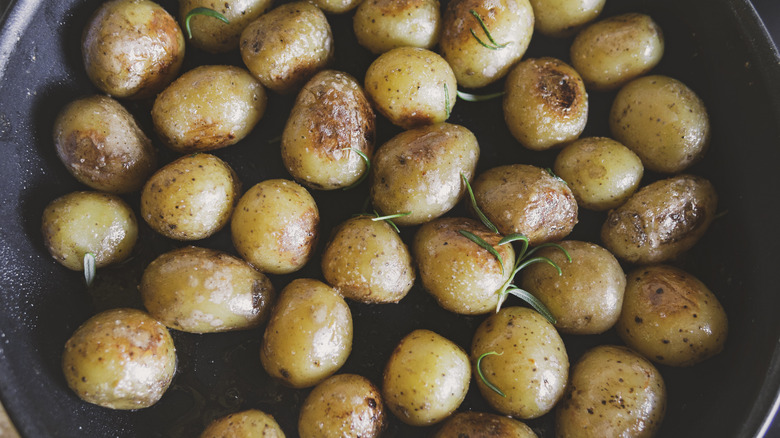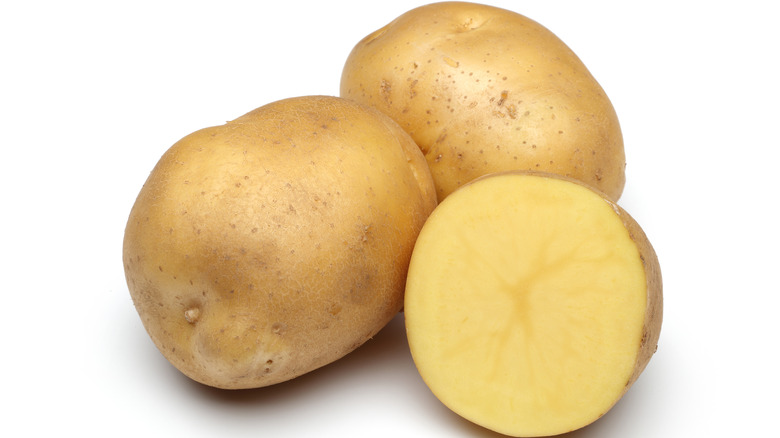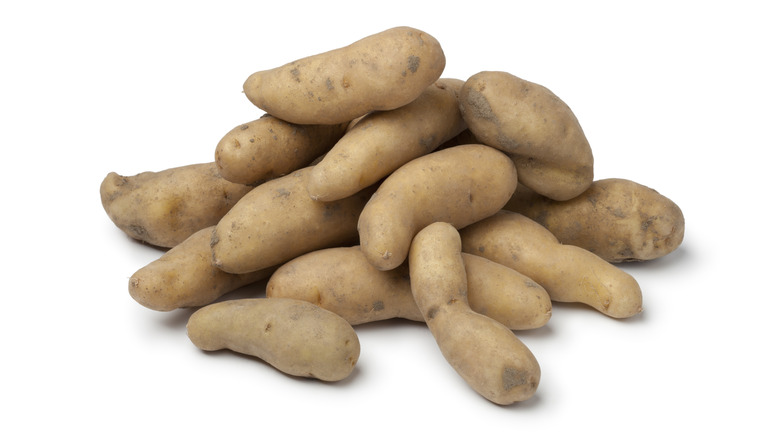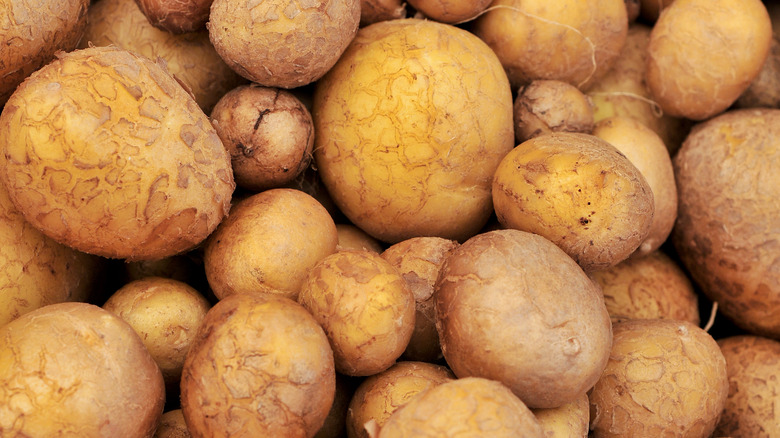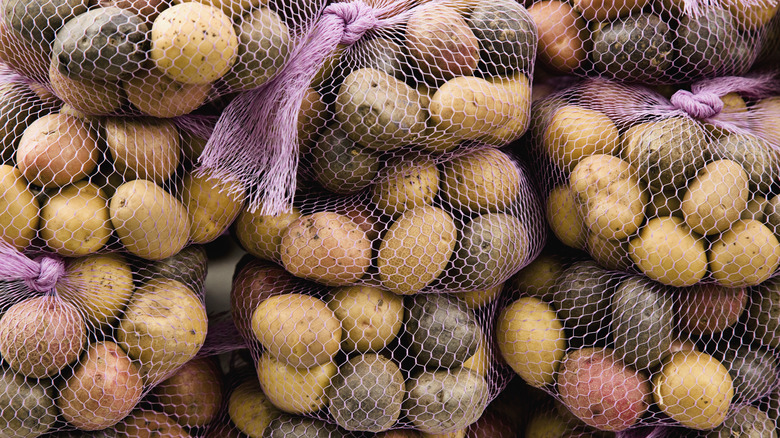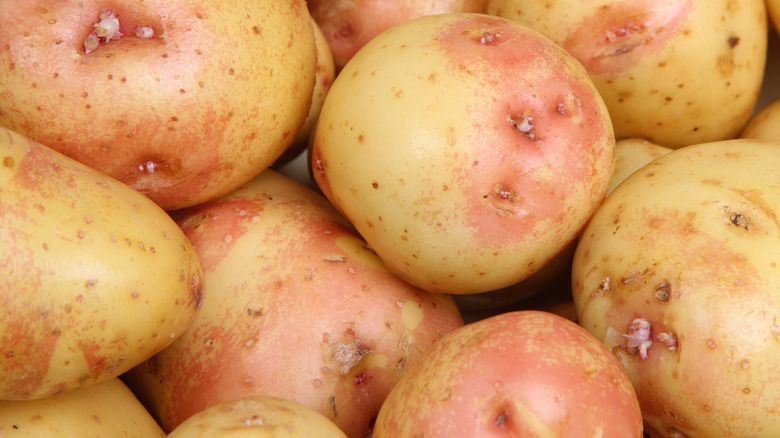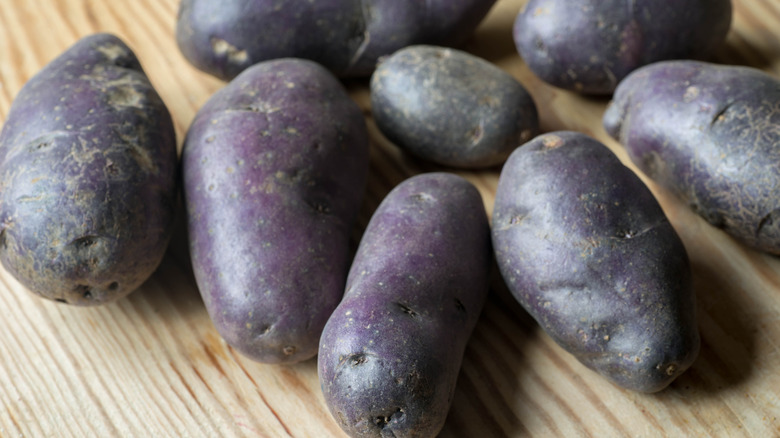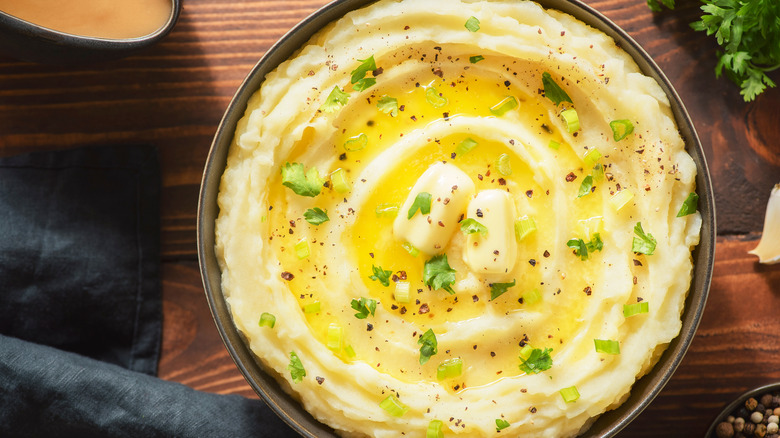7 Best Potatoes For Mashed Potatoes And The Ones You Should Avoid
When made right, mashed potatoes are creamy, buttery, soft, and perfectly seasoned with salt and pepper, so it's no wonder we all love them so much. However, considering there are more than 4,000 types of native potatoes, making the perfect mashed potatoes isn't always as straightforward as you think. If you've ever found yourself looking at all the varieties of potatoes in the grocery store and wondered which to buy — or if it even matters — you know what we mean.
There are three main categories of potatoes: Starchy, waxy, and all-purpose. Some create a fluffy texture when mashed, and others wind up forming an undesirable paste. As a general rule of thumb, all-purpose potatoes make the best mashed potatoes if you like a heavy, rich consistency, and starchy potatoes are ideal if you prefer a fluffy texture. Even so, there's a bit more to it than that.
Whether you're new to making mashed potatoes or are a seasoned pro, you will benefit from knowing which potatoes are best for this classic dish. To determine the right and wrong potatoes for the job, I considered their categorization, top chef recommendations, and my extensive experience cooking and enjoying mashed potatoes, but I'll go more in-depth on methodology at the end of this article. Keep reading to learn the seven best potatoes for mashed potatoes and the ones you should avoid so that you can make them perfect every time.
Best: Yukon Gold
When it comes to making mashed potatoes, Yukon Golds are arguably the best potatoes you can use. When mashed, they create a velvety, rich consistency that many chefs swear by. For example, Gordon Ramsay uses them for his famous pome pureé, which is just fancier name for mashed potatoes. Not only do Yukon Gold potatoes have smooth skin that is easy to peel, but their light buttery colored flesh stands up well after being boiled and gives your dish a delightful color.
Yukon Gold potatoes are considered all-purpose potatoes, but they have a distinct waxy element. As a result, their high moisture and medium starch content make them perfect for dense mashed potatoes. They may not make the fluffiest mash, like a starchy potato, but their creamy texture is beyond decadent and delicious. Plus, they are widely available at grocery stores, so you shouldn't have any issues finding them. So, if you want to make the richest, smoothest mash possible, there's no better choice than Yukon Gold potatoes.
Avoid: Red
Red potatoes, also called Red Bliss, fall into the small waxy potato category, which is not ideal for mash. Their waxy, thinner skin and texture help them stay extra firm while cooking, which comes with benefits, just not for mashed potatoes. Sure, red potato mash can be done, but it is difficult to achieve a smooth consistency, and mashing them takes a considerable amount of effort. Red potatoes are also relatively small compared to other varieties, and their skins are thin, so peeling them can be tedious.
I admit, I've made mash with red potatoes quite a few times because I like their color and subtly sweet taste, but according to top chefs, they're not really suited for the job. I also really enjoy mash with the skins and a few chunks, so they work well for that. However, mashed potato purists would argue my rustic rendition of mashed potatoes is nothing like a pomme pureé, which people see as the golden standard for mash. Instead, red potatoes are better suited for making roasted potatoes, soups, stews, and salads.
Best: Russet
Depending on who you talk to, there's also a strong argument for Russet potatoes being the best for mashed potatoes. When you think of potatoes, Russets are probably the first ones that come to mind, even if you didn't know that is what they're called. They have brown skin with dimples and a rough texture. While they are suitable for almost any recipe, they really excel in a classic mashed potato recipe. They have a high starch content, which means they fluff up nicely and are absorbent. Their sponge-like qualities quickly soak up all the yummy ingredients found in mashed potatoes, like cream, butter, salt, and pepper, resulting in a fluffy, flavorful mash overall.
Many mashed potato recipes call for Russets, including Martha Stewart's. Even so, there are a couple of things to keep in mind. First, the absorbent nature of Russet potatoes also means they soak up more water when boiling, so don't cut them into small pieces, or they could become saturated. Second, you want to make sure you don't over-mash them, or they can form the dreaded gluey texture we are all trying to avoid. I've overworked Russet mashed potatoes before, and once you go too far, there is no turning back. To avoid ruining your side dish, always stop mixing as soon as you reach a smooth consistency. Don't let these minor details deter you, though. If you prefer a super fluffy mash, Russet potatoes should be your number one choice.
Avoid: Fingerling
There are several different fingerling potato varieties, but whether you're cooking Russian Banana, French, or some other kind, they all fare better in recipes that don't require mashing. That's because they hold their shape exceptionally well while cooking and have waxy flesh, which we know isn't the best for mash. They are also rather small and firm compared to other kinds of potatoes, so peeling them is less than ideal. As the name suggests, they also resemble short fingers, so they are knobby and slender, further complicating peeling and mashing.
The majority of fingerling potatoes found in the United States have buttery or pale brown colored skin and light yellow flesh. However, French fingerling potatoes have red skin and yellow flesh with patches of pink. Either way, they have an earthy, nutty taste that adds flavor to an array of dishes. As opposed to mashing, they excel when roasted, boiled, or fried. Conveniently, they are well-suited to preparing whole. When done correctly, the result is wonderfully crispy fingerling potatoes that make a fantastic side dish for any meal of the day.
Best: Idaho
You may be wondering, aren't Idaho potatoes Russet potatoes? The answer is yes, well, kind of. Idaho potatoes are, in fact, Russets, but they must be grown in Idaho, just like bourbon must be made in Kentucky. So, all Idaho potatoes are Russets, but not all Russets are Idaho potatoes. According to the Idaho Potato Commission, what makes them different and special is the ideal growing conditions in Idaho, including climate, rich volcanic soil, irrigation, and more. As an all-purpose potato, Idaho potatoes are incredible in a wide range of recipes. They withstand boiling, roasting, and baking nicely, hold their shape in stews and soups, and even withstand the microwave quite well.
Like other Russet potatoes, Idaho potatoes have a high starch content and an absorbent flesh. This winning combination results in the perfect, fluffy mash bursting with rich flavor. They soak up all the cream, butter, and seasonings you add while still fluffing up into perfect mashed peaks. If you've ever tried boxed, dehydrated mashed potatoes, there's a good chance they were made with Idaho potatoes. Not only because they are ideal for mashing but also because one of the most recognizable brands is Idahoan Original Mashed Potatoes.
Avoid: Jersey Royals
For several reasons, Jersey Royal potatoes are less than ideal for mashed potatoes. First, they are small, so they are more challenging to peel and work with. Second, they have firm waxy flesh with a low starch content and lots of moisture. As a result, they don't absorb a lot of cream and butter, and they won't fluff up like your typical Russet potato. According to Specialty Produce, Jersey Royal potatoes have lots of vitamin C in their skin, but that's not enough to make them good for mash.
Whether this is considered lucky or not, you're unlikely to wind up with Jersey Royal potatoes by mistake. They aren't the easiest to find, especially in the United States. They also have a relatively short season and are primarily found in Great Britain and the island of Jersey, where they were initially discovered and are still cultivated (via Specialty Produce). If, by some random chance, you come across them and you want to give them a try, forget mashed potatoes and sauté, roast, or bake them instead.
Best: Desiree
Desiree potatoes are highly regarded by top chefs like Gordon Ramsay as a great alternative to Yukon Gold potatoes for pomme pureé, according to his restaurant group's website. They have red skin and yellow flesh that is low in moisture. They also have a nice blend of starchy, floury, and waxy potato characteristics (per Specialty Produce). Desiree potatoes have a tender consistency that makes mashing easy and a neutral, earthy taste that is only enhanced by butter, cream, and seasonings. With all this in mind, you can see why they make an excellent choice for mashed potatoes.
They may have red skin, but Desiree potatoes aren't to be confused with Red Bliss potatoes, which we know aren't the best for mash. Originally from the Netherlands, Desiree potatoes are popular across Europe, particularly Italy and the U.K. (via Specialty Produce). As an all-purpose potato, they make a wonderful ingredient for all kinds of potato recipes. From crispy baked, fried, and roasted potatoes to potato casseroles to mash, they perform exceptionally well.
Avoid: Peewee
All you have to do is look at a bag of Peewee potatoes to know they are a lousy choice for mashed potatoes. Compared to other potato varieties, they are super small and round, making peeling them beyond tedious. Additionally, Melissa's Produce notes that they are a good source of vitamin C and potassium when unpeeled, so why bother if it means you'd be wasting the extra nutrition, too? Peewee potatoes do have a creamy texture and light flavor, but it takes more than that to make a good mashing potato.
The small size of Peewee potatoes works to their advantage when making roasted, baked, and smashed potatoes. They don't need to be chopped or peeled and cook up rather quickly compared to larger potatoes. If you can't find these baby Dutch yellow potatoes in a package of their own, you may still be able to purchase them in a bag of rainbow potatoes with small purple, red, and fingerlings.
Best: Yellow Finn
Aptly named, Yellow Finn potatoes are golden yellow in color, both inside and out. Considered somewhat waxy potatoes, you may think they are less than ideal for making mashed potatoes, but they are an exception to the rule. Their skin is silky, and their flesh has a low starch content, so they fall on the spectrum between waxy and all-purpose potatoes. Yellow Finns also have a rich, buttery flavor that embodies everything you want from a bowl of delicious mashed potatoes. When you add cream and butter, it only makes them taste even better.
Like Yukon Gold potatoes, Yellow Finns may not be your first pick if you prefer a super fluffy mash, but they definitely are good if you enjoy a super creamy, heavy textured mash. Actually, they look a lot like Yukon Golds, too, so don't get them confused when picking out produce at the grocery store. Yellow Finns also range in size from small to large, so you'll want to grab larger ones to make peeling and mashing easier. In addition to mashed potatoes, Yellow Finn potatoes are a great fit for a myriad of other recipes. They are perfect for a basic potato salad, roasting, baking, and steaming.
Avoid: La Ratte
Similar to fingerling potatoes, La Ratte potatoes have a knobby oblong shape and are relatively small in size. They have a smooth, dense, waxy texture that holds its shape quite well when cooked. While this makes La Ratte potatoes a good choice for roasting, baking, sautéing, braising, and boiling, it hinders their performance when it comes to making mashed potatoes. Obviously, peeling them sounds like a nightmare, too. Not only would it be pretty tricky, but it could be hazardous as well.
According to Chefin, La Ratte potatoes also produce a low yield and are prized by professional chefs, so they can be hard to find. If you do manage to locate some, they are likely to be expensive, too. However, if you get a chance to try them, don't pass it up. The distinct nutty flavor of La Ratte potatoes is quite unique. It has elements of hazelnut and pairs wonderfully with a variety of spices and flavors, like thyme, garlic, various types of vinegar, mustard, and more.
Best: German Butterball
If the name didn't already give it away, German Butterballs taste delicious when used for mashed potatoes. They're called butterballs for a reason, and butter is one of the best parts of mashed potatoes, so it makes sense. In addition, they range in size from medium to large, so they are easy to peel and chop into smaller pieces for boiling. Aside from their name reflecting their buttery taste, German Butterballs also have a firm, waxy texture — but after cooking, they become smooth and tender. They are an all-purpose potato with a low starch content, but when mixed with cream and butter, the taste and consistency are mouth-wateringly delicious.
German Butterball potatoes were first introduced in 1988 (via Specialty Produce). As a relatively new potato on the scene, especially in the United States, they probably won't be stocked at a typical grocery store. However, they can commonly be found at farmer's markets and specialty produce stores. Or, if you really want to give them a try, you can always try growing them in your home garden. Since they're all-purpose potatoes, you can use them for a lot more than just mashed potatoes.
Avoid: New potatoes
When you hear the term new potato or baby potato, it does not denote a specific variety as you might expect. Instead, the interchangeable terms refer to any kind of potato harvested before reaching full maturity (via MasterClass). What this means is that even a Yukon Gold or Russet potato can be called a new potato if it is dug up early enough. While some varieties of baby potatoes are typically perfect for mashed potatoes when picked at peak maturity, the restricted size and reduced amount of flesh present when "new" makes them much more labor intensive when it comes to peeling and bulking up a dish like mash.
Baby potatoes can be found at every grocery store. They often come in a mixed bag along with other petite potatoes, like red, purple, or fingerling. Frequently, bags of rainbow potatoes consist entirely of new potatoes. While they may be cute and colorful in various dishes, mashed potatoes aren't one of them. Leave them for roasting, baking, and frying, and you'll be glad you did.
Best: King Edward
Eye-catching and adaptable, King Edward potatoes feature smooth skin with golden, rosy, and light tan to brown colors. The flesh inside is white with a dense texture. When cooked, they easily transform into a creamy yet fluffy mash. Whether you like airy, starchy, or velvety mashed potatoes, they make a fantastic choice. King Edwards also have a buttery taste that lends itself to a rich flavor when mixed with cream and butter. Even if you don't add butter, which I don't recommend, their inherent taste makes dishes buttery.
King Edward potatoes are regarded by home and professional chefs as one of the most multi-purpose potatoes. Their versatility makes them ideal for a variety of dishes, not just mashing. They are great for recipes that involve roasting, baking, boiling, and more. In the United Kingdom, they are frequently used in holiday dishes and are referred to as a "classic Christmas" potato (via Specialty Produce). Locating King Edward potatoes in the United States is more challenging than many of the other outstanding varieties on our list for mashed potatoes. Specialty produce shops and growing them at home are your best bet if you want to incorporate them into your mashed potato recipe.
Avoid: Purple
Purple potatoes come in a broad range of varieties. From Violette to All Blue to Purple Majesty to countless more, they fall under the purple potato umbrella. Depending on the specific type, they come in almost every size imaginable and have a spectrum of textures. While some may be okay for mash, in general, they aren't the best. Often, purple potatoes are sold in a bag as rainbow potatoes, so they are relatively petite and less than ideal for peeling, boiling, and mashing. However, considering these potato varieties have purple flesh, they make for an eye-catching dish, regardless of how you serve them.
Admittedly, saying all purple potatoes should be avoided when making mash isn't entirely fair because of how many varieties exist. While some are small and absorbent, leading to poor-quality mash, others are larger, creamier, and better suited to the task. One example is Adirondack Blue potatoes, which, according to the Michelin Guide, are suitable for mashing. Purple Majesty potatoes can also make a good mash, but they are pretty demanding in this type of recipe. They quickly become gluey if over-whipped and require extra milk and butter to achieve the ideal creamy consistency. All things considered, purple potatoes, as a whole, definitely don't fall under the best category for mashing potatoes.
Taste and texture helped us determine the best and worst potatoes for our list
With thousands of potato varieties available worldwide, I seriously had to narrow down the choices to compile a list of the seven best potatoes for mashed potatoes and the ones to avoid. To achieve this feat, I placed a lot of importance on two things that have the ability to make mashed potatoes truly exceptional: taste and texture. After all, that's what makes them so drool-worthy, right? I also considered online recommendations from top chefs like Martha Stewart and Gordon Ramsay regarding whether starchy, all-purpose, or waxy potatoes make for the best mashed potato recipe.
Additionally, I love mashed potatoes. I know, most people do, but I make them at home all the time, and not just from a dehydrated package. So, I took into account my extensive experience cooking and consuming various kinds of potatoes, whether I wound up mashing them or not. Lastly, I worked in restaurants for 20 years, so I thought about which potatoes made the best mash and made sure to include them on my list.
Next time you're in the grocery store looking for the perfect potatoes for a dish, remember everything we learned, and you'll already be miles ahead of the novice home cook.

